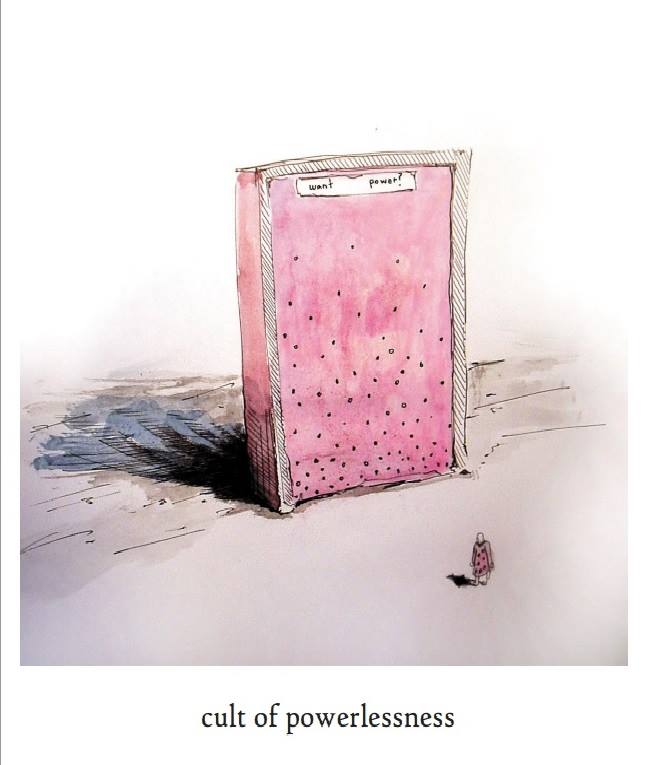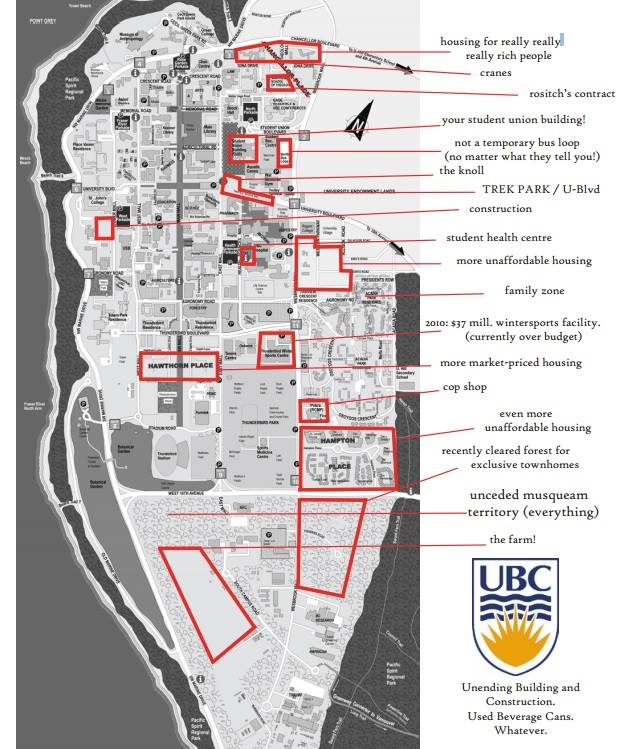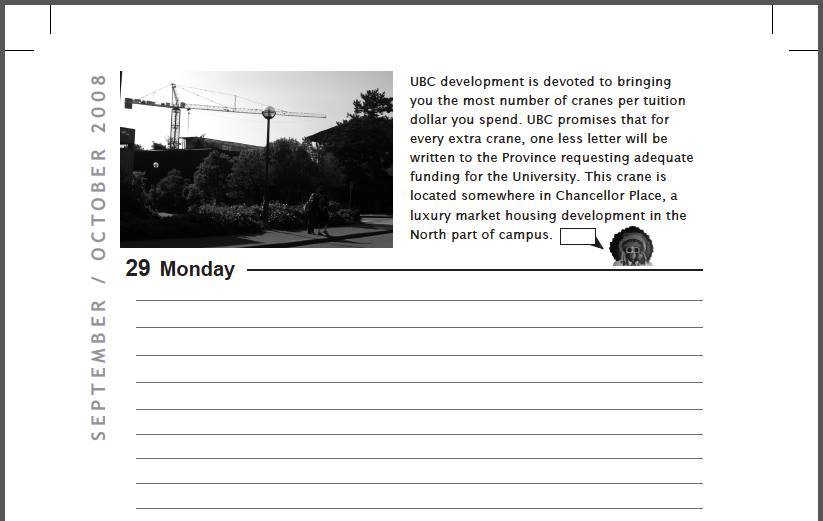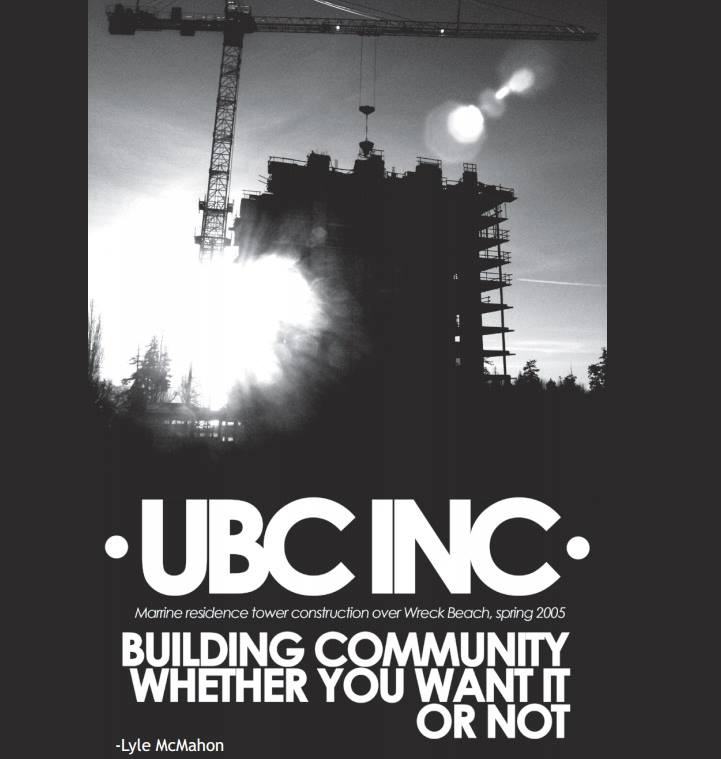This is part two of an interview series on The Knoll, a grassroots student press that was active on campus from 2006 to 2010. Former editors Nathan Crompton, Tristan Markle, and Bob Neubauer sat down with The Talon to talk about the original grassy knoll, real-estate development at UBC, the history of their activism on campus, and the radical origins of the New SUB.
While the first part of this series focused on The Knoll press and protests, the second segment is focused on the nature of the centre of campus development and the resistance student organizers faced from the Alma Mater Society (AMS).
Former Knoll editor Tristan Markle was heavily involved with the AMS, serving as the Vice President of Administration in the 2008-9 school year. During his time in office he passionately advocated against tuition hikes, both on campus and as a student lobbyist at the BC Provincial Legislature in Victoria. Markle was also part of a student uprising against corporate development of the campus, including condo development on the UBC Farm and in the campus core.
Construction was slated to begin in the centre of campus in 2008. If the plan had gone ahead, the entry point of UBC would have been an underground bus loop, topped by a shopping mall and a set of luxury condos. The project was viewed as highly problematic for a number of reasons, including its undemocratic process, the penetration of campus by corporate interests (pushing out non-profit student-run space), and the fact that affordable student housing on campus was (and still is) sorely lacking.
While this may not be a full history of the new SUB, it offers an interesting insight into the history of development on campus, and perhaps more importantly, into the history of the AMS and its capacity to serve the interests of students.
_________________________________________________________
It’s easy to get the impression that the APEC protest and mass-mobilization on campus failed to achieve anything concrete – How do you look back at your time organizing at UBC?
Nathan: I would argue that the resource groups are the concrete institutional result of that APEC mobilization. I would say our generation didn’t leave anything quite on that level, except for the fight against the development of the centre of campus. Tristan’s the best to talk about that, because Tristan got involved with the Student Union [Note: The Alma Mater Society/AMS] and implemented the student union’s capacity to block the $49 million bus loop in the center of campus along with the condos and the shopping mall that students were supposed to be flowing through on their way to class every day.
Tristan: I would say the way activism progressed was: the anti-APEC protests in 1997, then the right-wing took over until 2004, then there was a little wave in 2004 with the {{SPAN}}[[SPAN]]Student Progressive Action Network – a former AMS slate[[SPAN]] and Amina Rai who was president of the AMS at that time. They got crushed almost immediately by the right-wing though, who banned slates that year, and then there were two or three years of right-wing suit-wearing, pro-tuition types. Then our wave came to sweep them out.
What do you mean when you say slates, what are you referring to?
Nathan: Parties for the student union, basically.
Bob: Slates made it a lot easier to have an actual political movement, a class, or any demographic-based movement. When you force people to run as individuals you’re basically getting people to run off their CV’s – “Oh I ran this camp and I did this thing with the residence association.” Which is interesting because it’s totally reactive. It’s interesting how much time the university and the right-wing spent, after APEC, and while we were there, and probably still now, reacting to what students were doing – like banning slates.
Nathan: It helped that Stefanie Ratjen, myself, and Tristan were already recognized as part of the student left so when we ran it was already a clear project, even though we couldn’t run in a slate.
And the AMS – the student union, how did that play into resistance against campus development?
Tristan: It all contributed, it was a year-long thing.
Nathan: It was interesting what the student union did. Part of it was that the redevelopment of the Student Union Building – the New SUB – was literally a turf war, with the AMS making the strategic decision to build the Student Union Building on top of the university’s plans [for the bus loop].
Tristan: The students ran our own referendum. There’s a lot of criticisms I could make of this, but let me explain what happened first. My campaign was built on a student levy to build a new student-run centre, once we had that leverage of money we had negotiations with the university to get the land to build it. I insisted we put it where they were going to put the bus loop. I was also trying to keep the Old SUB for us too.
The Student Union had dozens of meetings with the university’s engineers, and we had our own engineers. Basically what I did was stall them. It was very enjoyable for me: “What do you mean! The pillar can’t go there because the student union building pillar is going to go there! Look at this thing it’s not going to work. Look at our blueprints!” And then their engineers would say: “But look at our blueprints!”
I would be on one side of the boardroom and the Campus VP would be on the other side and we’d be giggling to ourselves.
Nathan: Then TransLink, the province, and municipalities started talking about doing a transit line on the Broadway Corridor. It’s funny now because if they go ahead with that – which has tons of problems and lots of criticisms that you can make of it – they’d benefit from not having their $49 million dollar bus loop – it would be obsolete.
Tristan: I think it’s important to tie in the environmental movement because all this was literally happening at the exact same time as the fight to save the UBC farm.
Bob: It was almost like you couldn’t separate out the movements: Farm Aid and Knoll Aid.
Tristan: I always talked about it as two legs, one in Centre Campus and one in South Campus. We had the big farm trek march, a 3000 person march, at the same time we were killing the bus loop plans. I was meeting with one group of people for the bus loop plans and then I’d run to another meeting with the farm people to save the farm.
Nathan: At that point it was literally like the farm was gone. The farm was going to be condos.
Short video from 2008 explaining opposition to centre campus development featuring Tristan and Nathan.
The impression I get with UBC is that community consultations don’t really do anything. Can you talk a little bit about the consultation process?
Nathan: Development consultations, like the centre of campus, was a sham. But we did organize around it. The university would have breakout consultations and we would have a Knoll militant at each one derailing the process.
How would they do that?
Nathan: Well there were certain transparent aspects of the consultation. You needed to get written submissions from everyone and catalogue them and put them on a website. So we would flood them.
Bob: Our side was motivated. The neutrals were way less likely to get involved in a consultation and the right were just content to piss on our dome.
Nathan: Again, thinking about involvement in municipal politics, I do think its interesting to reflect on the two different strands of politics in the city now. There are two anti-development strands. The {{NIMBY}}[[NIMBY]]”Not In My BackYard,” referring to a subset of property owners who take issue with certain development projects in their neighbourhood on the premise that these developments will affect their living situation and neighbourhood negatively. It is especially relevant in relation to homeowners who block homeless shelters and low-income housing projects in their neighbourhood.[[NIMBY]] strand, which is property owners organizing in the city. The other strand is people organizing from a social justice lens, around how land-use happens.
And again this is a bit of self-criticism but everything NIMBY’s do, like sentimental attachment to place, being deeply immersed in a consultation process, petitioning, we were doing all these things for a social justice purpose. Our class analysis did sometimes disappear in that fog of the democratic process. Maybe I’m being too self-critical.
I mean, there’s more I can say about being NIMBYs, it goes on and on, there’s an article in the handbook that someone wrote that’s basically a tirade against cranes and overdevelopment of campus, which is ridiculous because campus is not overdeveloped, it’s sparse, it’s a colonial model. This whole idea of, “there are cranes blocking my way to class,” that’s annoying, but no, that’s not our politics, we’re not trying to found a politics about complaining about cranes blocking the skyline or blocking our path.
We don’t use those tactics anymore. Getting involved in the consultation process at city hall, there’s no question where the balance of power lies in that.
Bob: It was a bit different in this situation though. They would have a bullshit consultation and then we would kick up so much shit that they would have to have ANOTHER bullshit consultation to make up for the first one. There were lines of flight that were opened up in certain ways because we were involved in that process. It may have been harder to do if we had gotten ourselves arrested in say, the second week of classes, as opposed to later in the year.
Nathan: I think our politics in a lot of ways were undeveloped.
Bob: I agree with that.
Nathan: Talking about the SDS now, not The Knoll, our critique of neo-liberalism was quite young in our minds and talking about university democracy without a grasp of the totality of neo-liberalisation, not just in the university, but of the public infrastructure of all of BC in the last twenty years. The question of what it meant for us to have democratic control at the university so that we would be overseeing this large process of austerity…
I just felt the politics around it weren’t as developed, I guess for me personally. I discovered Marxism not just as critique but as a potential for mass organizing only at the very end of my involvement at UBC.
But you’re talking about subverting these consultations in a specific way here. What were your tactics?
Tristan: Here’s something that would happen. We would say [to the university]: “These plans you have are bullshit.” We would use the student union, petitions, etc, we would say to them: “We want some alternatives.” They would ask us for feedback, present alternatives, and we would organize to flood their comments and their submissions. The next week they would release the results of the consultation and it would be like 90% of the students oppose the plans, and it would make them look really bad. We would show up at student council and rake the university over the coals. In some ways we were on the offensive throughout the consultations. We forced them to do things that would open up a new opportunity to mess up their process. They were on the defensive and they were backpedalling the whole time until things collapsed.
Bob: We willed this into being ourselves. They were just going to get away with it fly by night, so we would force them to have a consultation that you KNOW would be bogus to create this symbolic construction so you could in turn say: “look how bogus this is.” It was like out of Zizek or something! The consultation was always already bogus.
That’s why we would organize another issue of The Knoll every time a consultation popped up.
I would say for the record I actually do think that forcing them to do the consultation at UBC was a good idea but it’s not a political argument for me that the far-left should get more involved with City of Vancouver consultations.
But this ended up being a victory, you didn’t end up having the bus loop. Was that because of the consultations?
Tristan: Not just the bus loop, everything. All their development plans in the centre of campus, from the shopping mall, to retail, to the condos.
Bob: The university was only pretending to be interested in the bus terminal because they were interested in building a mall. They couldn’t just say – “lets build a mall.” They would say – “we need to build this bus terminal, but we have to pay for it somehow…”
This is an interesting question. I will make the potentially controversial move and take the Gramscian position, and argue that any kind of radical or revolutionary movement inevitable involves a diverse constellation of tactics, institutions, actions, etc that cannot always be identified a priori with theory or even historical analysis. So I don’t think the consultation ‘stopped the bus loop’, but I think that consultations in conjunction with Knoll Aid, Trek Park, taking over the AMS – all of the different, interconnected manifestations of thee movement – together helped us beat them . But not because of the consultation per se. usually – and I agree with Nate and Tristan here – consultations are a waste of time.
What matters here, in my opinion, is the way we were able to integrate these totally bogus consultations into our movement. Not institutionally, because obviously the consultations were simply manifestations of the UBC and the Board of Governor’s hegemonic apparatus. But symbolically we could use the consultations to point out that students didn’t like the bus loop, that democracy at UBC was a sham, etc. Tactically and sociologically as well – because the consultations were leveraged by us in this way, and also probably helped build bridges with sympathetic people: “look at these bogus consultations! We should work with the other students to stop these guys!” So in these ways we were able to redefine the meaning and function of the consultations, and integrate them into our discourse and tactics – in a way that’s usually impossible with these sorts of things. And THAT I think is the type of phenomenon which probably deserves more thought and consideration on the left when thinking through strategy.
Tristan: The bus terminal was all very strategic. We were only against the bus terminal because it was the foundation of the plan for which they were going to build the rest. And the student-led coalition to save the Farm from condo-development also prevailed that same year. We celebrated at the end of 2009 with a 3000-strong march across campus.
Part 3 of the Knoll series will include discussion of the de-politicizing of campus and the infamous 2008 GSS Handbook.








